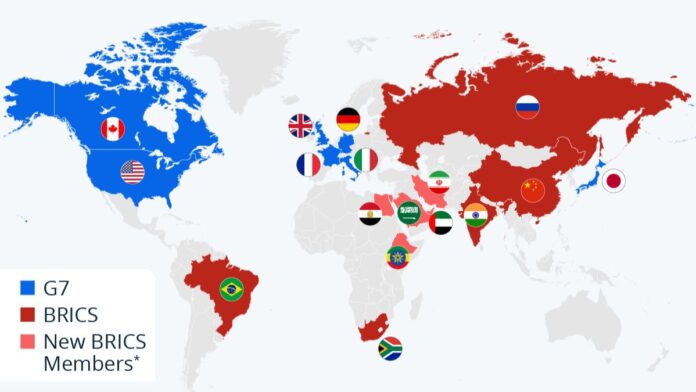
KUALA LUMPUR — Malaysia is now officially a BRICS country partner, allowing it greater opportunities with other emerging economies also part of the Russia-chaired platform that represents 40% of the global population.
Economists have suggested areas of focus for Putrajaya to leverage on its country partner status in the bloc that accounts for one-fifth of global trade and US$26.6 trillion in cumulative gross domestic product or 26.2% of the world’s GDP, nearly matching the economic strength of the Group of Seven (G7).
Samirul Ariff Othman, economist and adjunct lecturer at Universiti Teknologi Petronas (UTP) said that Malaysia, which is rich in natural resources and with growing expertise in green technology, could become a regional hub for energy collaboration with BRICS members.
“Similarly, the digital economy—spanning artificial intelligence (AI), financial technology, and e-commerce—offers vast opportunities for technological exchange and innovation partnerships. Malaysia must position itself as a digital bridge between BRICS economies and Southeast Asia,” he told Scoop in his personal capacity.
With Brazil, one of BRICS’ founding members, Malaysia can also leverage on its reputation as a global leader in agriculture, where its agricultural exports in 2023 were valued at approximately US$120 billion, Samirul added.
Brazil is the world’s largest exporter of soybeans, coffee, and sugar, and as the leading country of that region within BRICS, can be Malaysia’s “stepping stone” into the South American market, said another economist, Professor Emeritus Barjoyai Bardai of the Malaysia University of Science and Technology (MUST)
As for BRICS chair Russia, Samirul said that Malaysia, with its robust oil and gas sector, can engage in joint ventures and technology sharing to bolster energy security and explore new markets. This is because the country is the world’s second-largest natural gas producer and is among the top oil producers, with energy exports constituting a significant portion of its economy.
India and China are two other BRICS founding member countries, each with their own strengths Malaysia can leverage on, he added.
With India, Samirul said Malaysia can collaborate with Indian firms to advance its digital economy and healthcare sector given that its IT industry is a global force – with over US$194 billion in revenue in 2023 – and that India is a leading producer of generic pharmaceuticals, which supplies 20% of the global market.
As for China, Malaysia can attract Chinese investment in manufacturing and infrastructure projects, enhancing industrial capacity and connectivity.
Originally established in 2009 as an economic cooperation platform with founding members Brazil, Russia, India, and China, BRICS added South Africa the following year, and has since expanded to include Iran, Egypt, Ethiopia, and the United Arab Emirates.
“By strategically engaging with each BRICS member’s economic strengths, Malaysia can diversify its trade partnerships, enhance technological capabilities, and strengthen its position in the global economy,” Samirul said.
On South Africa, he noted its mineral resources, being the world’s largest producer of platinum and a significant producer of gold and diamonds. In 2023, the mining sector contributed about $24 billion to South Africa’s gross domestic product (GDP).
“Malaysia can engage in resource exchange and collaborate on mining technologies, securing access to essential raw materials for its industries,” Samirul added.
Besides Malaysia, other countries that have joined BRICS as country partners are
Algeria, Belarus, Bolivia, Cuba, Indonesia, Kazakhstan, Nigeria, Thailand, Turkiye, Uganda, Uzbekistan and Vietnam.
Geopolitical play
By becoming a BRICS country partner, Samirul said Malaysia would not only be engaging in an economic play but also in a geopolitical play.
“How does Malaysia balance its deep economic ties with the West while deepening engagements with BRICS heavyweights like China, India, and Russia?
“Can Malaysia carve out a role as an Asean leader in BRICS-related dialogues, advocating for regional interests while building stronger bilateral ties with individual BRICS members?” Samirul said, referring to Malaysia’s chairmanship of the Asean bloc this year.
Similarly, Barjoyai noted that BRICS partner status would bring changes to previously established relationships.
“This will change the (trade) equation where we were relying so much on North America and Europe. We can balance it with the relationship with the Asian region, as well as the Middle East and Russia,” the MUST academician said.
As part of navigating these changes, Samirul said Malaysia needs to commit itself to certain reforms to prepare itself for economic collaborations at the BRICS level.
These reforms include structural, policy frameworks, financial systems and governance mechanisms.
He said the private sector must also be leveraged, as it is an “underutilised asset”in Malaysia’s foreign economic strategy.
“(The private sector) must be brought into the fold. (Additionally), business chambers, trade delegations, and corporate leaders should actively engage with their BRICS counterparts to unlock market opportunities,” Samirul added.
Malaysia must also develop clear benchmarks, performance metrics, and transparent reporting mechanisms on its economic engagement activities with BRICS nations, which will be essential to ensure accountability and progress.
A BRICS strategy cannot simply consists of press releases and photo ops, and must be translated into tangible economic gains, job creation, and long-term resilience, he added.
Focus areas: de-dollarisation and maximising existing FTAs
Meanwhile, Barjoyai said that Malaysia should not look solely at the immediate economic benefits from BRICS, but remember its goal to slowly detach from the US dollar.
He said Malaysia as well as many other countries are too dependent on the West for their economic growth; and that Malaysia is very reliant on the greenback to back its currency, its reserves and its trades.
“(Though) we are recognised as an independent country (as well) as a country that tries to be impartial in our associations, …this reliance on the US for example, has been very traditional, and so we have expressed our intention to go into this de-dollarisation.
“By becoming a BRICS partner, we have an opportunity to do that.”
Samirul meanwhile, touched on free trade agreements (FTAs), suggesting that Malaysia avoid rushing to create new ones with BRICS nations, and instead maximise existing ones. These include the Regional Comprehensive Economic Partnership (RCEP), which already covers China and represents nearly 30% of global GDP.
For Barjoyai, the subject of new FTAs with BRICS members is related to de-dollarisation, and an alternative currency by the bloc.
“We are waiting on the development of the BRICs currency. If it becomes an alternative to the US dollar, that may create a new equation in world trade.”
Malaysia must also continue making itself attractive as a prime trade and investment destination, as BRICS nations collectively drive nearly 37% of global GDP.
“Malaysia can attract targeted investments by offering tax incentives, reducing bureaucratic red tape, and promoting its industrial zones as fertile ground for BRICS capital,” Samirul said.
On the threat made by President-Elect Donald Trump of 100% tariffs on BRICS countries, Barjoyai played it down, saying the US did not have such power to do that, while noting that it had a “very localised economy”.
“They (US) consume 80% of their (local) production, and they only import 20%.
“(Additionally)the US potential as an export market for Malaysia is actually not that big except for semiconductors, and the semiconductor market is right now being readjusted and rearranged in the sense that the American manufacturers are moving into Asia for the semiconductor manufacturing and products so that they can also export to China now that they ban semiconductor export to China, for example,” Barjoyai added. – January 1, 2025



